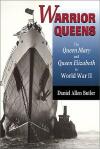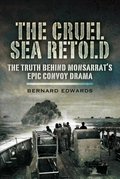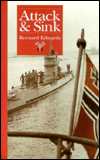Warrior Queens
The Queen Mary and Queen Elizabeth in World War II
Butler, Daniel Allen
2002, Stackpole Books
ISBN 0811716457
Hardcover, 224 pages
| Type. | General History |
| Pros. | Detailed, well researched and a good read |
| Cons. | Slightly old-style anti-German in 1-2 places, but other than that nothing much |
| Rating. |  |
 This book deals with the sister ships Queen Mary and Queen Elizabeth launched in 1936 and 1940 respectively, the largest and most impressive ocean liners ever built at the time. The pride of Britain, built to win the Blue Ribbon for fastest cross-Atlantic crossing, they were instead used to transport more than one million troops during the war.
This book deals with the sister ships Queen Mary and Queen Elizabeth launched in 1936 and 1940 respectively, the largest and most impressive ocean liners ever built at the time. The pride of Britain, built to win the Blue Ribbon for fastest cross-Atlantic crossing, they were instead used to transport more than one million troops during the war.
The launch and escape of Elizabeth from Clyde, Scotland in February 1940 and her trip to America to escape the German Luftwaffe are described. She could only be launched and sailed down the Clyde on 2 days during the war - Feb 26 and Aug 26 - due to her massive draught and size.
Their extensive and complex conversion into huge troop carriers is given a very good coverage and the difficult question of whether to limit the troops on each passage to 8000 (maximum number that could be given life rafts, boats and floats in case of sinking) or to fill them to the max, roughly 16.000 troops (which was the way chosen).
Each liner (known as the "Grey Ghosts" due to their grey paintjob) was considered its own convoy, sailed without escort most of the way across and could carry an entire division of troops (over 15.000 men, plus almost 900 crew). Without even one of them the war would have been harder to win, so important were their contributions. They also both carried a huge number of Axis POWs to North America, as Britain was in no way capable of holding all those POWs by itself, especially after D-Day.
Some of the more notable events during the war are covered, such as the disastrous ramming and sinking by Queen Mary of the cruiser HMS Curacoa off Ireland, and the near loss of one of them to a huge rogue wave in December 1943 (this would have been both the worst maritime disaster ever with over 11.000 persons on board, and probably a huge mystery since she was unescorted and most if not all would have perished).
There were also a few cases where U-boats crossed the paths of these great liners, but still this was extremely rare, such was their secrecy in all regards. The closest call was perhaps when U-704 (Kessler) fired 4 torpedoes on the Queen Elizabeth on 9 November 1942. He heard a single detonation and claimed a hit, but did not hit the ship (probably a premature explosion due to bad weather). Had this attack sunk the ship the results would have been severe for the Allies, for none other than Alan Turing, a key figure in the Allied fight to crack the Enigma, as well as loads of other important British government officials and army officers were on board.
In early 1942 U-129 (Clausen) and U-161 (Achilles) were also only mere miles away from the Queen Mary when she cleared the Anagenda Passage from the Caribbean and into the Atlantic again, en route from New York to Sydney, Australia. U-407 (Brüller) also claimed to have fired 4 torpedoes without results on Queen Mary on 1 October, 1942.
Oh, yes, during the war the Germans apparently sank both ships a number of times, if you would believe Herr Göbbels’ radio broadcasts. The captain of Queen Mary took perverse pleasure in this each time he heard his ship had been sunk. The radio broadcasts were not purely bad propaganda as the Germans were also trying to trick the British into demanding that the ship in question would call in and confirm its safe state, in doing so of course allowing the Germans to fix its position by intercepting the origin of that radio call. But the British (themselves masters of such ploys) never fell for this.
Finally the book covers the post-war careers of both ships and their final fates, Queen Elizabeth’s burning and capsizing in Hong Kong harbour on 9 January 1972, and Queen Mary’s permanent service as a floating hotel and convention center at Long Beach, California since 1967.
This is a very well researched book, as are the author’s other books (The Full Story of RMS Titanic and Lusitania) - very well worth the read in my view. Excellent work!
The only down side I can find with this book is the occasional, but rare, reference to U-boat men as nasty killers of the sea. Such beliefs should have long since been buried in light of accurate historical research.
Review written by Guðmundur Helgason.
Published on 31 May 2002.
This title is highly recommended.
Purchase information: (info) Get Warrior Queens now at amazon.co.uk
Get Warrior Queens now at amazon.co.uk
Return to our main review page.



